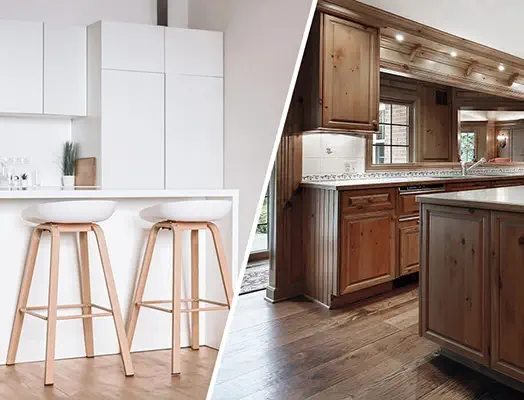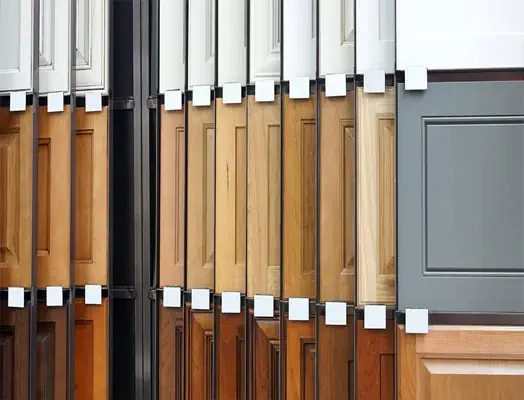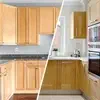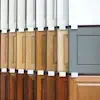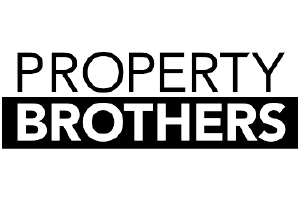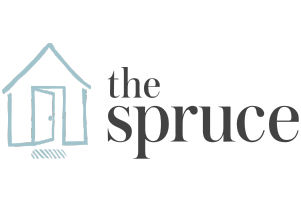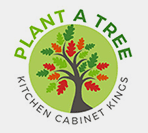11 Types of Wood Cabinets: From Solid Cherry to MDF

The type of wood cabinet you choose will drastically change the aesthetics in your kitchen. While many wood species can be stained, finished, or painted, others have stunning grain patterns that are best left in their natural state. Wood types also have varying degrees of durability and quality, and external factors such as light and chemical exposure can impact the look of cabinets over time.
Keep reading to learn more about different types of wooden kitchen cabinets, plus tips on how to make the best choice for your design preferences, budget, and lifestyle.
Table of Contents
Types of Wood Cabinets: Side-by-Side Comparison
For a quick side-by-side comparison of different cabinet wood types, check out the chart below.

| Durability | Price | |
|---|---|---|
| Cherry | High | $$$$ |
| Maple | High | $$$ |
| Red Oak | Moderate | $$ |
| White Oak | High | $$$ |
| Bamboo | High | $$$$ |
| Hickory | High | $$$ |
| Birch | Moderate | $ |
| Pine | Moderate | $ |
| Alder | Moderate | $$ |
| Walnut | High | $$$$ |
| Medium-Density Fiberboard | Moderate | $ |
1. Cherry

Cherry wood cabinets are a go-to for traditionalists. Cherry is a durable hardwood with a straight, closed grain and smooth texture. Cherry cabinets are known for their naturally rich and luxurious dark color, with variations ranging from deep yellow to pale red. The material absorbs stains and finishes well - varnished, glazed, or all-natural finishes are the best options to capture the character of the wood.
Cherry is a high-end material, so it's more expensive than other types of wood cabinets - typically 15% to 25% more than maple or oak. The higher price point warrants a lifetime value, with extreme durability that seldom chips or dents. Expect these cabinets to naturally darken with age and sun exposure.
Pros
- High quality
- Extremely durable
- Moisture-resistant
- Stain well
Cons
- Very expensive
- Aging process can be unpredictable
- Color variations can affect uniformity
2. Maple
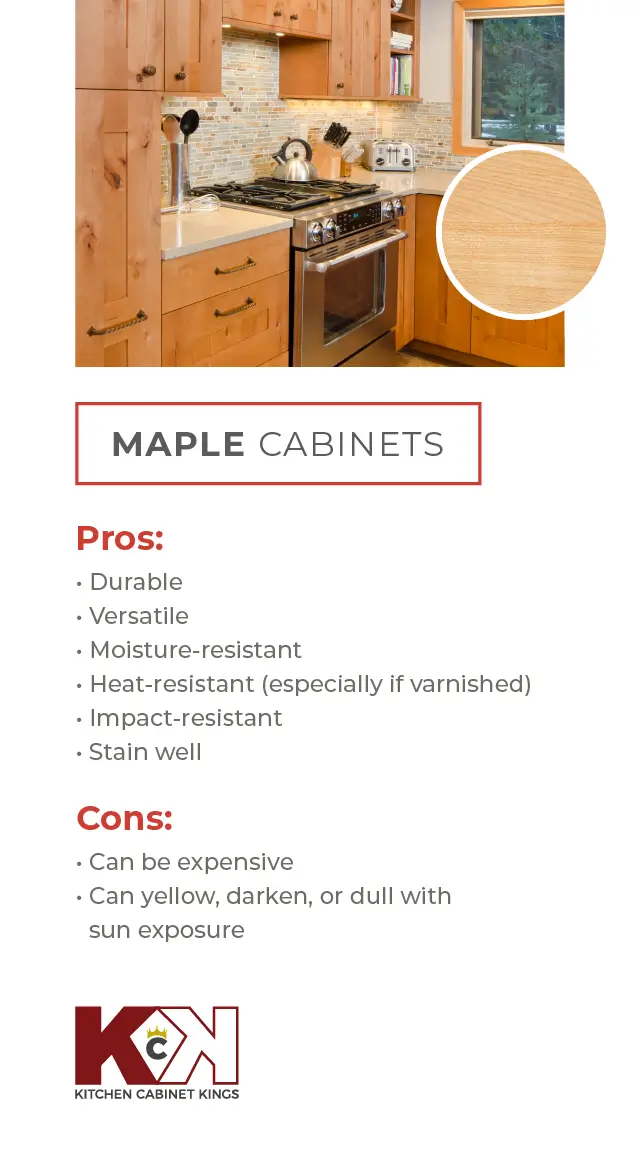
Maple wood cabinets are known for their durability, fine texture, and smooth grain. You may find varying bird's-eye dots, mineral streaking, and curling grain on different maple wood pieces. The wood's naturally pale to creamy white color makes it a popular choice for contemporary and modern kitchens. However, maple takes many different stains and finishes, so it can work with various design styles.
Exact costs vary based on factors like location and size of your space, but a standard 10- by 12-foot kitchen with top and bottom ready-to-assemble (RTA) maple cabinets can cost anywhere from $2,500 to $6,000.
Maple's durability is perfect for modern kitchens that get frequent use, making these types of wood cabinets a long-term investment in your dream kitchen.
Pros
- Durable
- Versatile
- Moisture-resistant
- Heat-resistant (especially if varnished)
- Impact-resistant
- Stain well
Cons
- Can be expensive
- Can yellow, darken, or dull with sun exposure
3. Red Oak
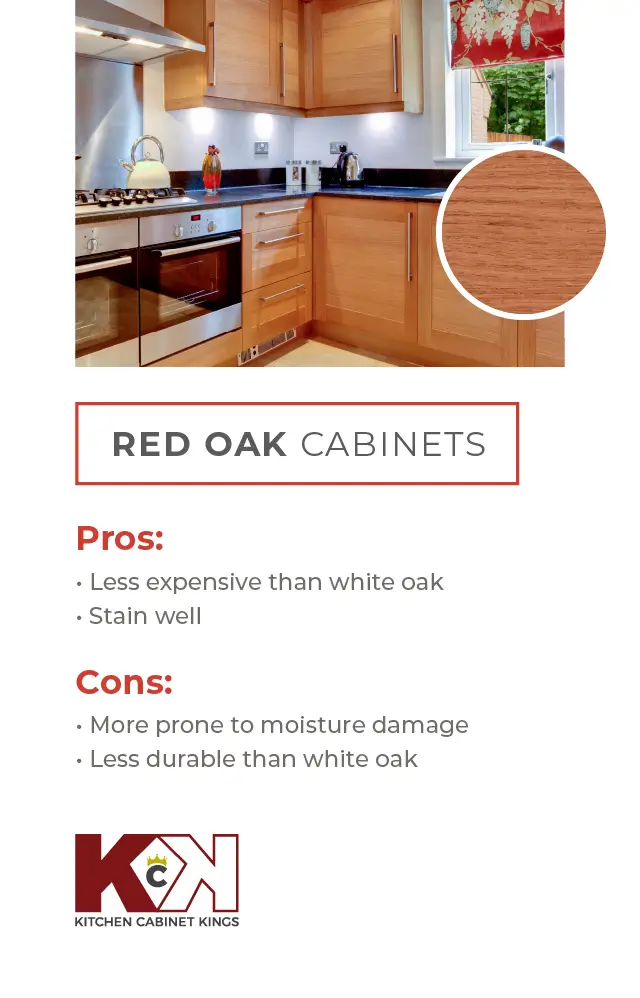
Of the many oak wood species, red and white oak are the most common. Both types are durable and affordable, making oak a popular cabinet choice. Oak wood cabinets stain well, while distinctive flame-like patterns of the grain are instantly recognizable.
Red oak is an open-grain wood, meaning it's softer and more porous than white oak. It also has bolder grain patterns and is slightly lighter in color than white oak, with a subtle reddish hue.
These qualities make for a welcoming aesthetic in rustic and traditional homes. Red oak wood is lightweight, easy to clean, and durable for everyday wear - a perfectly inexpensive hardwood.
Pros
- Less expensive than white oak
- Stain well
Cons
- More prone to moisture damage
- Less durable than white oak
4. White Oak

Unlike red oak, white oak is a closed-grain wood. This makes it less porous and more resistant to moisture and other elements. It is slightly darker than red oak, with honey or golden tones and a subtle grain. These characteristics work especially well with contemporary or modern design aesthetics.
While it's possible to stain white oak cabinets, it's best to keep it minimal (and avoid painting) to let the wood's natural appearance shine. However, it can yellow with sun exposure over time.
White oak is less readily available than red oak, making it the more expensive option.
Pros
- Durable
- Moisture-resistant
- Rot-resistant
Cons
- More expensive than red oak
- May not stain well
- Can yellow with sun exposure
5. Bamboo
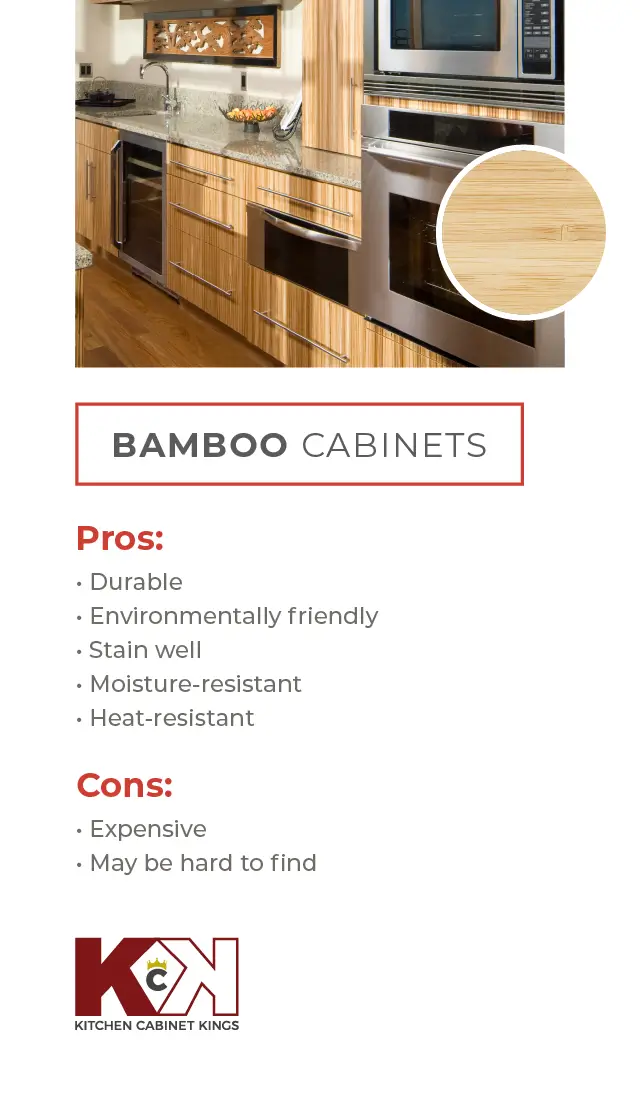
Bamboo wood cabinets are an eco-friendly cabinetry option. Unlike traditional wooden cabinets that are cut from planks made from large trees, bamboo boards are assembled from stalks cut into strips and laminated together. The orientation of the strips creates vertical graining.
Bamboo cabinets are extremely sturdy, and the laminated surfaces easily resist dents, chips, and dings. The light colors add an airy and modern look to kitchens, though they can be stained or finished in darker hues. Bamboo is also resistant to climate change and won't expand or contract like wood.
Bamboo is still relatively rare in kitchen cabinetry, so it may be difficult to find and will likely be more expensive than other hardwood options.
Pros
- Durable
- Environmentally friendly
- Stain well
- Moisture-resistant
- Heat-resistant
Cons
- Expensive
- May be hard to find
6. Hickory
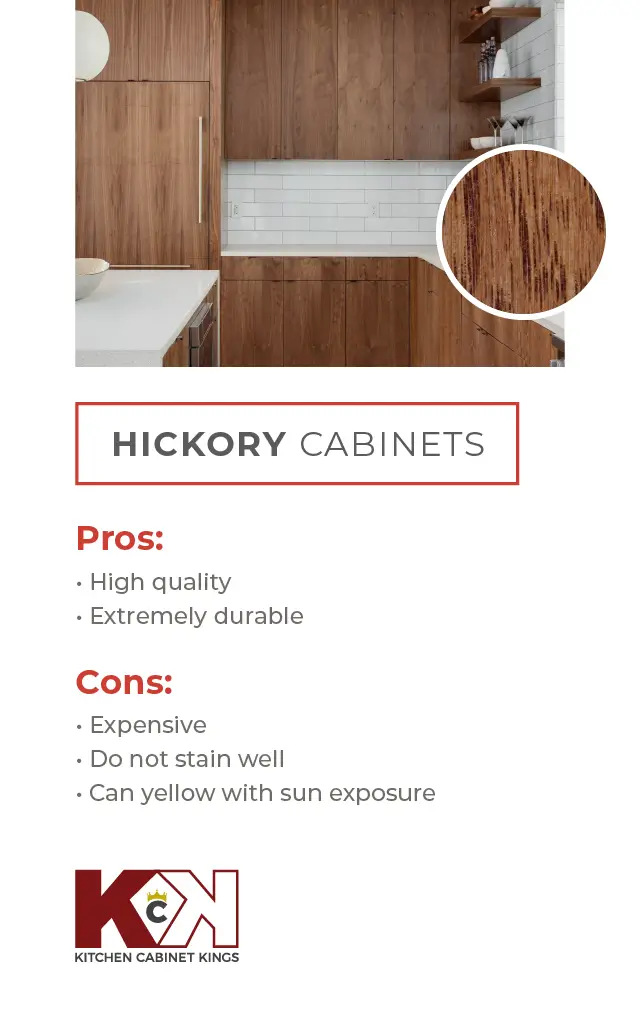
Hickory wood cabinets are an affordable counterpart to cherry wood and give a rustic aesthetic. Hickory's unique two-toned appearance consists of natural streaks of lighter white and darker reddish wood.
Because a stain can't penetrate the tight grain of this wood and veining can vary in a single cabinet, hickory wood cabinets are typically sealed with a clear finish. Compared to other types of wood cabinets, hickory cabinets are incredibly durable, often lasting for decades.
Pros
- High quality
- Extremely durable
Cons
- Expensive
- Does not stain well
- Can yellow with sun exposure
7. Birch
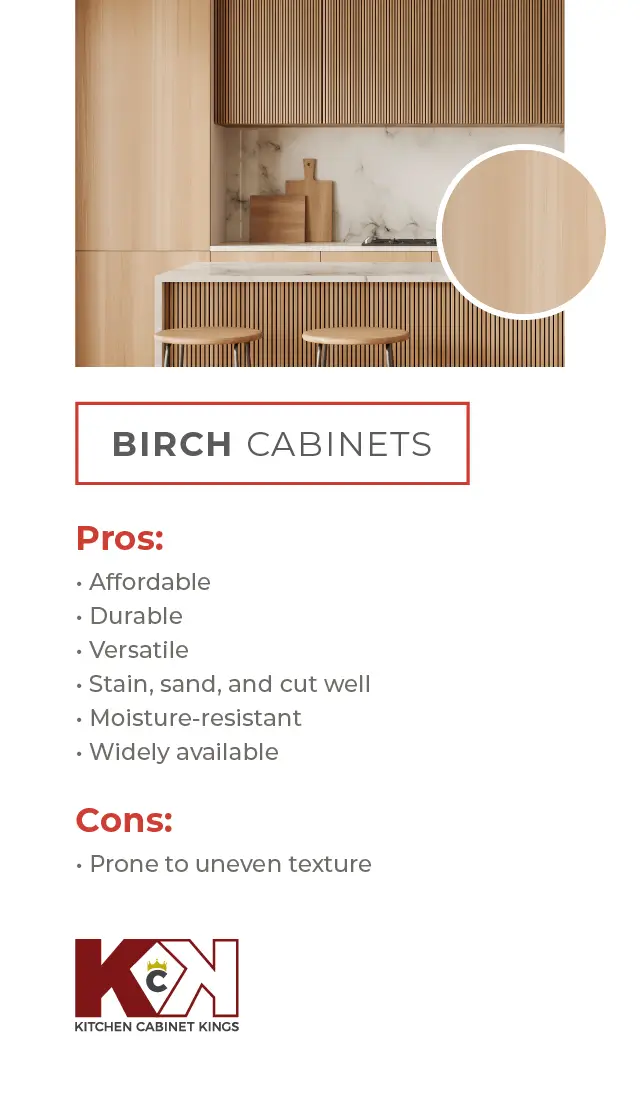
Birch wood cabinets are less expensive than maple wood cabinets and other popular hardwoods - a 10- by 12-foot kitchen with top and bottom RTA birch cabinets costs approximately $2,000 to $4,000. Birch wood cabinets have a uniform appearance and lack distinctive graining for easily receptive staining.
The surface is closed and nonporous and can be easily painted or paired with other decorative treatments. If you're looking for types of wood cabinets that fit your budget, finished birch can easily impersonate its more expensive counterparts: mahogany, walnut and maple. Yellow birch is also durable, with a tensile strength that holds nails well, making it ideal for construction.
Pros
- Affordable
- Durable
- Versatile
- Stain, sand, and cut well
- Moisture-resistant
- Widely available
Cons
- Prone to uneven texture
8. Pine

The aesthetic of pine wood cabinets are often associated with cabins, but can also work well in contemporary kitchens with up-to-date hardware and modern countertops.
The eco-friendly and affordable nature of pine makes this softwood option popular. Additionally, the material is light-colored and absorbs both natural and dark stains. Graining and knots of pine usually persist after staining.
While pine is easy to work with, it's also more prone to scratches, dents, and other damage than its hardwood counterparts.
Pros
- Affordable
- Stain well
- Widely available
Cons
- Not as durable as hardwoods
- Susceptible to damage
- May yellow with sun exposure
9. Alder
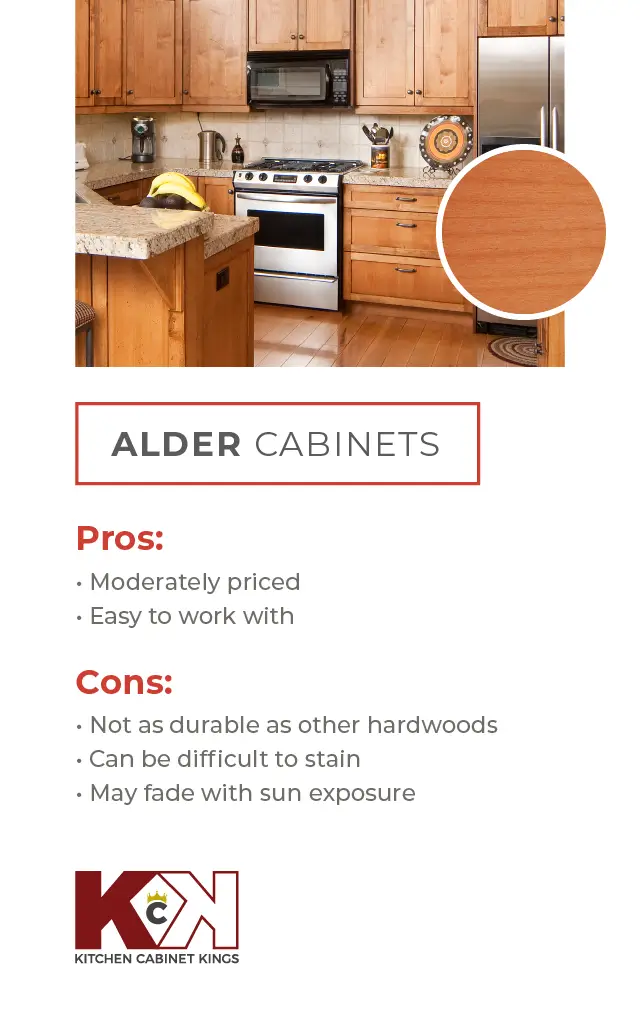
Sometimes called "the poor man's cherry," alder wood cabinets have a similar reddish tone and a smooth grain - perfect for a rustic aesthetic. You can also choose between smooth and knotty patterns depending on your taste.
Alder is softer than other hardwoods, making it easy to work with. However, that also means it's more susceptible to dents, scratches, and other damage. Alder wood also requires a specific finishing treatment that can be expensive.
Pros
- Moderately priced
- Easy to work with
Cons
- Not as durable as other hardwoods
- Can be difficult to stain
- May fade with sun exposure
10. Walnut

Of all the types of wood cabinets available, walnut might be the most durable. Walnut wood's natural oils protect it from scratches, fingerprints, and cracks, so it's a great choice for homes with children and pets.
Walnut is also beautiful, with colors ranging from dark brown to reddish gray. It has a straight, smooth, fine grain that often features intricate patterns like swirls. Walnut wood cabinets are versatile and work just as well with traditional styles as more modern ones.
Like white oak, walnut cabinets can be stained, but many people let walnut's natural beauty shine with a clear cabinet finish or very subtle stain.
Pros
- Extremely durable
- Versatile
Cons
- Expensive
- High maintenance
- Fade over time
11. Medium-Density Fiberboard (MDF)
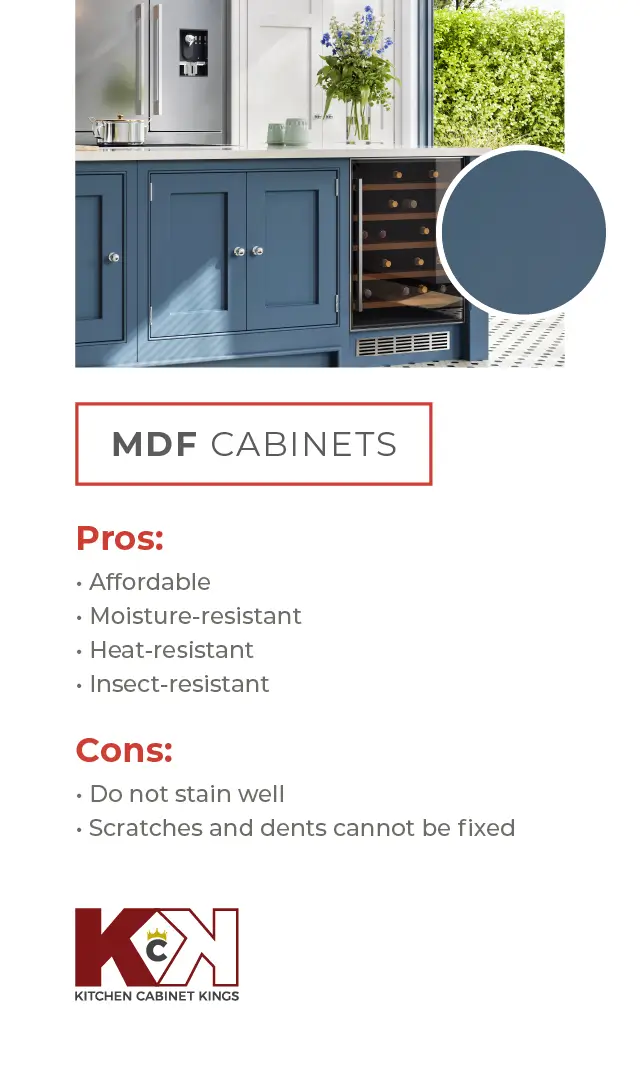
Medium-density fiberboard cabinets (MDF) are an affordable alternative to solid wood. MDF may also be a better option if you plan to paint your kitchen cabinets.
Wood expands and contracts with natural temperature fluctuations, leading painted finishes to bubble or crack. With proper sealing, MDF cabinets resist climate change for a smooth, blemish-free painted finish.
Unlike natural wood cabinets, MDF has no graining and is ideal for cutting with a jigsaw to create custom inlays and embellishments. It's also a more affordable material, coming in at $100 to $280 per linear square foot compared to $250 to $400 per linear foot for maple.
Pros
- Affordable
- Moisture-resistant
- Heat-resistant
- Insect-resistant
Cons
- Do not stain well
- Scratches and dents cannot be fixed
How To Choose the Best Type of Wood Cabinet for Your Space
With so many options available, determining the right material for your kitchen cabinets can be difficult. However, the top factors to consider when comparing types of wood cabinets are quality, durability, and cost. Here's how to evaluate your options and choose the best material for your needs.
Evaluate Quality
Carefully consider the quality of the cabinet material you choose. Natural woods like cherry or maple are known for being high-quality choices, though you shouldn't underestimate less expensive options like birch or MDF - these materials can still offer sufficient quality and durability.
While cabinet material is an important factor, the quality of the cabinets' construction is key. Here are some things to look for:
-
Plywood vs. particle board cabinet boxes: Plywood is a sturdy, durable material made from compressed wood sheets, and it's considered the higher-quality option for kitchen cabinets. Look for all-plywood construction for cabinets that will stand the test of time.
-
Soft close hinges and drawer glides: You'll likely use your kitchen cabinets every day, so cabinet hinges and drawers should be able to endure significant wear and tear. Soft close hardware keeps your cabinet doors and drawers from slamming shut, increasing their lifespan.
-
Dovetail joints: Low-quality drawer boxes with notched joints tend to fall apart or sag over time. Dovetail joints prevent this from happening by strengthening the drawers' structure.
-
Full-height back panels: Full-height cabinet backs (preferably made of plywood and at least ⅜ inch thick) support the cabinets, preventing collapse.
-
I-beams: I-beams are ½-inch stretchers installed on base kitchen cabinets. They provide extra strength, allowing cabinets to keep their shape during shipping and installation and preventing sagging and bending over time.
It may be tempting to compromise on quality to cut costs, but you'll likely save money in the long run by choosing high-quality cabinets.
Consider Durability
Durability should also be a top priority when shopping for the best kitchen wood cabinets. As we mentioned in the previous section, construction quality significantly impacts durability, but so does your choice of cabinet material.
Cherry, walnut, maple, white oak, bamboo, and hickory are considered the most durable types of wood cabinets. Remember that kitchen cabinets are a long-term investment and should last you for years to come.
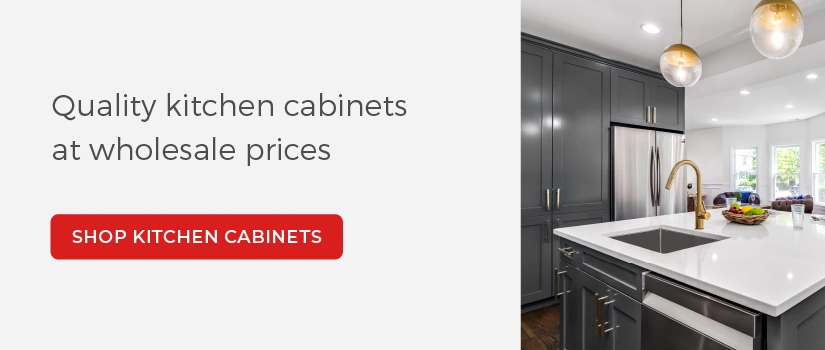
Compare Costs
Cost will likely be the biggest factor when it comes to choosing a kitchen cabinet material for your next remodel. If you're wondering what an appropriate budget is for new kitchen cabinets, experts recommend setting aside 15% of your home's total value on your kitchen remodel, with 30% of that sum going toward new cabinetry.
If the highest-quality, most durable materials are out of your budget, you can still achieve your dream kitchen with more affordable options. Materials like birch, pine, and MDF are much more cost-effective than higher-end materials. Choosing RTA cabinets over pre-assembled is also a great way to save money without compromising quality.
Use our handy kitchen remodel cost estimator for a complete breakdown of what you can expect to spend on your kitchen renovation.
Types of Wood Cabinets FAQs
Still have questions about types of wood cabinets? Here are answers to some commonly asked questions.
What are the three grades of cabinets?
The three grades of cabinets are:
- Stock: Pre-assembled and ready-to-assemble cabinets are the two types of stock cabinets. RTA cabinets arrive in kits that include all materials and hardware necessary for the homeowner to assemble them on-site, while pre-assembled cabinets are ready to install straight from the box. Stock cabinets are the perfect option for budget-conscious home renovators.
- Semi-custom: Semi-custom cabinets are a cross between stock and custom cabinets. You'll have more customization options than you would with stock cabinets, but they're not entirely made-to-order like custom cabinets (and not nearly as expensive!).
- Custom: Custom cabinets are made specifically for your space and offer the most diversity in terms of size, style, material, and finishes, but they are also the most expensive cabinet option.
What's the difference between soft and hardwood?
Hardwood comes from deciduous trees that shed their leaves in the fall and winter. These trees grow slowly and have a dense, complex structure.
Softwood comes from evergreen coniferous trees. They grow faster than hardwood trees and are less dense as a result.
As the name suggests, hardwood tends to be stronger and more durable than softwood, though there are hardwood species that are "softer" and vice versa - softwood species that are "harder." Hardwood also tends to be more moisture- and heat-resistant, as it's less porous than softwood.
What is the most durable wood for kitchen cabinets?
Cherry, hickory, and walnut are the most durable wood choices for kitchen cabinets, though maple, white oak, and bamboo are also durable options.
What are alternatives for wood kitchen cabinets?
Stainless steel kitchen cabinets are a great wood alternative for those who prefer a modern, industrial vibe. Manufactured wood can also be a cost-effective alternative to solid wood cabinets, including laminate, melamine, high- or medium-density fiberboard, particle board, and plywood. Some people choose to use a thermofoil or veneer covering on these cabinet faces to customize the final look.
With many different types of wood cabinets available, it can be challenging to make the best choice for both your desired kitchen aesthetic and budget. Our RTA and pre-assembled cabinets are the perfect solution, so you don't have to compromise on quality or price.







